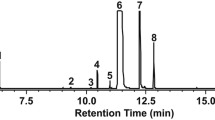Abstract
The sulfur-rich anal sac secretion of the mink,Mustela vison, consisted of immiscible lipid (1.7% sulfur) and aqueous (0.7% sulfur) phases. Light and electron microscopy revealed secretory tissue of two types, sebaceous (holocrine) and apocrine. A major input of sulfur into the sac appeared to be associated with glycoprotein granules present in the apical portions of the apocrine cells as X-ray energy probe microanalysis showed these to contain relatively high levels of sulfur. The lipid of the secretion, presumed to be largely of sebaceous origin, consisted mainly of wax monoesters, while the aqueous phase contained volatile fatty acids, ammonia, and amines, including putrescine (1,4-diaminobutane). The identity of the major headspace volatiles was confirmed by NMR, MS, and Raney nickel desulfuration as being 2,2-dimethylthiacyclobutane and 3,3-dimethyl-1, 2-dithiacyclopentane. These compounds were not detected by GC-MS in the headspace volatiles of the anal sac secretions of eight other mustelid species examined. Other sulfur compounds detected included isomeric dimethylthiacyclobutanes, a number of disulfides and 3-methyl-but-3-enyl methyl sulfide (isopentenyl methyl sulfide). The significance of these findings is discussed.
Similar content being viewed by others
References
Albone, E.S., andFox, M.W. 1971. Anal gland secretion of the red fox.Nature 233:569–570.
Albone, E.S.,Gosden, P.E.,Ware, G.C.,MacDonald, D.W., andHough, N.G. 1978. Bacterial action and chemical signalling in the red fox,Vulpes vulpes, and other mammals, pp 78–91,in R.W. Bullard (ed). Flavor Chemistry of Animal Foods. American Chemical Society Symposium Series, No. 67.
Albone, E.S., andGrönneberg, T.O. 1977. Lipids of the anal sac secretions of the red fox,Vulpes vulpes, and of the lion,Panthera leo.J. Lipid Res. 18:474–479.
Albone, E.S., andPerry, G.C. 1976. Anal sac secretion of the red fox,Vulpes vulpes; volatile fatty acids and diamines: implications for a fermentation hypothesis of chemical recognition.J. Chem. Ecol. 2:101–111.
Albone, E.S., Robins, S.P., andPatel, D. 1976. 5-Aminovaleric acid, a major free amino acid component of the anal sac secretion of the red fox,Vulpes vulpes.Comp. Biochem. Physiol. 55B: 483–486.
Andersen, K.K., andBernstein, D.T. 1975. Some chemical constituents of the scent of the striped skunk,Mephitis mephitis.J. Chem. Ecol. 1:493–499.
Brinck, C., Gerell, R., andOdham, G. 1978. Anal pouch secretion in mink,Mustela vison.Oikos 30:68–75.
Chandler, J.A. 1973. Recent developments in analytical electron microscopy.J. Microsc. 98:359–378.
Ewer, R.F. 1973. The Carnivores. Weidenfeld and Nicolson, London, pp. 90–100.
Freeman, L.R., Silverman, G.J., Angelini, P., Merritt, C., andEsselen, W.B. 1976. Volatiles produced by microorganisms isolated from refrigerated chicken at spoilage.Appl. Environ. Microbiol. 32:222–231.
Henbest, H.B., andKhan, S.A. 1968. Oxidation of sulphoxides in preference to that of sulphides.Chem. Commun. 1036.
Jorgenson, J.W., Novotny, M., Carmack, M., Copland, G.B., Wilson, S.R., Whitten, W.K., andKatona, S. 1978. Chemical scent constituents in the urine of the red fox,Vulpes vulpes, during the winter season.Science 199:796–798.
Kainer, R.A. 1954. The gross anatomy of the digestive system of the mink. II The midgut and the hindgut.Am. J. Vet. Res. 15:91–97.
Mayer, C. 1974. Eine einfache Synthese von 2,2-Dimethyl-thietan.Helv. Chim. Acta 57: 2514–2517.
McFadden, W.H., Seifert, R.M., andWasserman, J. 1965. Correlations and anomalies in mass spectra: Thioesters.Anal. Chem. 37:560–566.
Pearse, A.G.E. 1968. Histochemistry, Theoretical and Applied, 3rd ed. Vol. 1. J. & A. Churchill Ltd., London, pp. 294–380.
Preti, G., Muetterties, E.L., Furman, J.M., Kennelly, J.J., andJohns, B.E. 1976. Anal sac secretions of dog,Canis familiaris, and coyote,Canis latrans, anal sacs.J. Chem. Ecol. 2:177–186.
Rambourg, A. 1974. Staining of intracellular glycoproteins, pp 245–253,in E. Wisse, W.T. Daems, I. Molenaar, and P. van Duijn (eds.). Electron Microscopy and Cytochemistry. North Holland/American Elsevier, Amsterdam.
Richardson, K., Jarrett, L., andFinke, E.H. 1960. Embedding in epoxyresins for ultrathin sectioning in electron microscopy.Stain Technol. 35:313–323.
Schildknecht, H., Wilz, I., Enzmann, F., Grund, N., andZiegler, M. 1976. Mustelan, the malodorous substance from the anal gland of the mink,Mustela vison, and the polecat,M. putorius.Angew. Chem. Int. Ed. Engl. 15:242–243.
Scott, J.E., andDorling, J. 1965. Differential staining of acid glycosaminoglycans (muco- polysaccharides) by Alcian blue in salt solutions.Histochemie 5:221–233.
Silverstein, R.M., andBassler, G.C. 1967. Spectrometric Identification of Organic Compounds, 2nd ed. John Wiley & Sons, New York. p. 179.
Singer, A.G., Agosta, W.C., O'Connell, R.J., Pfaffmann, C., Bowen, D.V.,andField, F.H. 1976. Dimethyldisulphide: An attractant pheromone in hamster vaginal secretion.Science 191:948–950.
Sokolov, V.E. 1973. Skin of Mammals [in Russian]. Nauka, Moscow.
Sokolov, V.E., Chikildin, B.S., andZinkevich, E.P. 1975. Free volatile fatty acids from the anal gland secretion of the American mink,Mustela vison [in Russian]Dokl. Akad. Nauk. SSSR 220:220–222.
Sokolov, V.E., andZinkevich, E.P. 1974. Main principles of chemocommunication of terrestrial mammals. First International Theriological Congress Transactions, Vol. 2. p. 182, Nauka Moscow.
Wheeler, J.W., von Endt, D.W., andWemmer, C. 1975. 5-Thiomethylpentane-2,3-dione. A unique natural product from the striped hyena.J. Am. Chem. Soc. 97:441.
Wilz, I. 1967. Die Konstitution der Geruchskomponenten des Analsekretes von Nerzen. Dissertation, University of Heidelberg.
Author information
Authors and Affiliations
Rights and permissions
About this article
Cite this article
Sokolov, V.E., Albone, E.S., Flood, P.F. et al. Secretion and secretory tissues of the anal sac of the mink,Mustela vison . J Chem Ecol 6, 805–825 (1980). https://doi.org/10.1007/BF00990405
Received:
Revised:
Issue Date:
DOI: https://doi.org/10.1007/BF00990405




